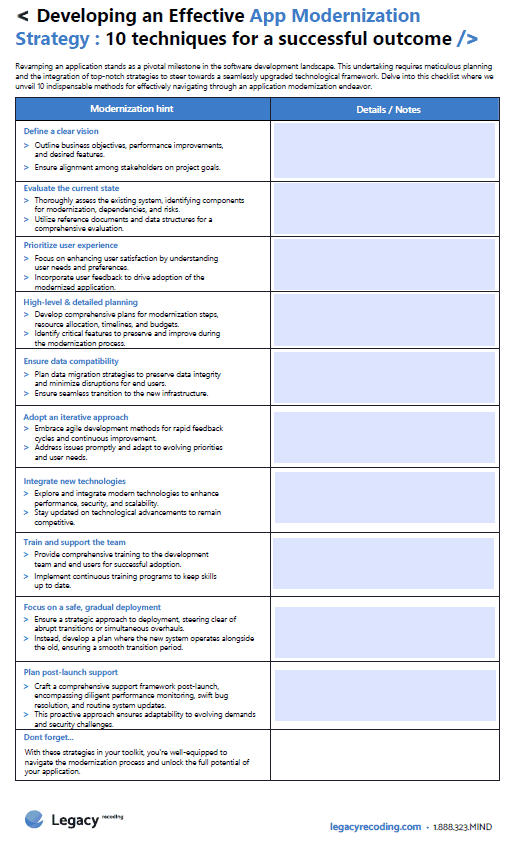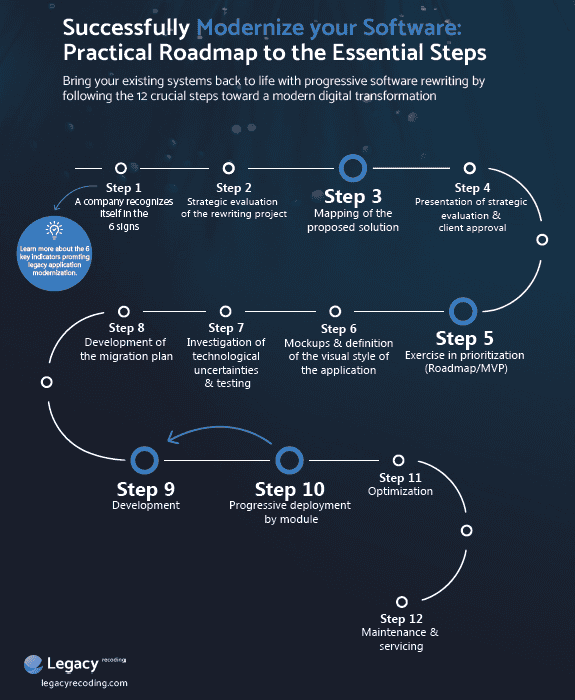Transform your app with our 10-point modernization checklist
Download our exclusive checklist now and unlock 10 winning strategies for a successful app modernization.

In today’s rapidly evolving technological landscape, data migration and data integrity are critical processes for businesses looking to modernize their legacy systems. Data migration involves moving data from one system to another, while data integrity ensures the accuracy and consistency of data over its lifecycle. These processes are particularly important for businesses using outdated software, as they seek to upgrade or modernize their systems without losing valuable data.
This guide will explore how to ensure data integrity during database migration, providing practical advice and real-life examples for business leaders.
Ensuring data integrity during migration is not just about transferring data; it also involves validating, cleaning, and transforming data to fit new environments, which ultimately supports better decision-making and operational efficiency.
Data migration involves transferring data between storage types, formats, or systems, often during an upgrade or consolidation. In contrast, data integration combines data from different sources to provide a unified view. Both processes are essential for modernizing legacy systems and improving operational efficiency. Data migration is typically a one-time process aimed at moving data from an old system to a new one, while data integration is an ongoing process designed to maintain data consistency and accuracy across multiple systems and databases, ensuring real-time data availability and seamless access across different platforms.

Transform your app with our 10-point modernization checklist
Download our exclusive checklist now and unlock 10 winning strategies for a successful app modernization.


According to a study by IBM, businesses that modernize their data management systems see an average productivity gain of 20%. For example, a manufacturing company using outdated software may struggle with inefficiencies and data inaccuracies. By migrating to a modern system, they can streamline operations and ensure data integrity, leading to significant productivity improvements. These productivity gains are not just limited to time savings; they also encompass improved data accuracy, reduced manual errors, and enhanced data accessibility, which collectively contribute to more informed business decisions and strategic planning.

One notable example is the data migration of a manufacturing conglomerate that optimized their SharePoint setup and migrated data to a more efficient system. This extensive project, managed by Eleviant, was essential for the company to address significant challenges in data access and operational inefficiencies across its multiple international regions. By undertaking this migration, the company improved the scalability and reliability of its data infrastructure. Eleviant’s team facilitated a seamless transition to a new international region, ensuring easier and faster data access for all business units. This project not only enhanced data accessibility but also streamlined operations, demonstrating the substantial benefits of a well-executed data migration (Eleviant). The successful completion of this migration underscores the importance of strategic planning and execution in overcoming the complexities associated with large-scale data migrations, particularly in a global context. This case study highlights how targeted improvements in data management can lead to significant operational gains and support better decision-making across an organization.
Data migration, when done correctly, can lead to substantial cost savings for businesses. By ensuring data integrity, companies avoid the expenses associated with data loss and rework. Proper planning and execution of data migration projects can significantly reduce the risks of data corruption and ensure that the data remains accurate and reliable throughout the migration process. This reduction in risk translates directly into cost savings, as companies can avoid the costs associated with data recovery, system downtime, and potential business disruptions.

A case study on AdvancedMD revealed that moving its administrative back-end to the cloud resulted in a reduction in capital expenditure (CapEx) costs and a smooth transition with improved data security. This highlights how prioritizing data integrity during migration can lead to significant cost savings and operational efficiencies. Additionally, cloud-based solutions offer scalable infrastructure that can grow with the business, providing flexibility and cost efficiency that traditional on-premises solutions may lack.

Consider the example of a large retail chain that migrated its legacy point-of-sale system to a cloud-based solution. By maintaining data integrity throughout the process, the company avoided significant downtime and data loss, ultimately saving millions in operational costs. This migration also enabled the retail chain to implement advanced analytics and reporting tools, providing deeper insights into customer behavior and inventory management, which further contributed to cost savings and improved business performance.
Selecting the right partner for data migration is crucial for ensuring data integrity. A data migration partner provides the expertise and tools necessary to navigate the complexities of data migration projects. The right partner will have a thorough understanding of both the source and target systems, as well as the potential challenges and pitfalls that can arise during migration. This knowledge is essential for developing a robust migration strategy that minimizes risk and ensures a smooth transition.

A reliable data migration partner will have a proven track record of successful projects, robust data management practices, and a deep understanding of the client’s industry. This ensures that the migration process is smooth and that data integrity is maintained throughout. Furthermore, a good partner will provide ongoing support and training to ensure that your team can effectively manage and utilize the new system post-migration, thereby maximizing the return on investment.

A financial services company faced challenges with outdated legacy systems that were unable to meet the stringent regulatory compliance requirements and operational demands of the modern financial landscape. The company partnered with a specialized data migration firm to not only upgrade their systems but also address the critical need for maintaining data accuracy and consistency. The migration firm’s deep understanding of the financial industry’s specific regulatory needs allowed them to design a tailored migration strategy. This included decoding complex data formats and ensuring that all financial data was migrated with full integrity. The partnership not only ensured a seamless transition but also provided the financial services company with advanced insights into optimizing their data architecture for enhanced scalability and future growth.
Data migration projects come with their own set of challenges. These can include outdated software, lack of cohesion between systems, the need for decoding complex data formats, handling proprietary encryption, and the risk of data loss during migration. Addressing these challenges requires a comprehensive understanding of both the existing and target systems, as well as a detailed migration plan that outlines each step of the process and includes contingency measures for potential issues.



Technologies such as ETL (Extract, Transform, Load) tools and data validation software can play a pivotal role in ensuring data integrity during migration. Companies like Talend and IBM Cloud offer robust solutions for data migration and integration, ensuring that data remains accurate and consistent. These tools not only automate the data migration process but also provide advanced features for data profiling, cleansing, and transformation, which are essential for maintaining data quality and integrity.
For more techniques on developing a successful application modernization strategy, check out our article on 10 techniques for achieving success in application modernization.

Download our free checklist and make sure you don’t miss anything during the modernization stages of your application.

Understanding Data Migration vs. Data Integration:
Productivity Gains:
Successful Case Study:
Cost Savings:
Choosing the Right Partner:
Common Challenges:
Practical Solutions:
Tools and Technologies:
Tell us more about your needs so that we can better route your project to our specific SWAT team.
1
During the brainstorming phase, we work with you to identify potential solutions to your business challenges to generate the technology response that aligns with your business objectives.
2
Through our requirements gathering process, we work closely with you to define and prioritize your needs, ensuring that our solutions are tailored to meet your specific requirements.
3
This phase marks the beginning of our partnership. We’ll finalize the project plan and establish clear communication channels to ensure a smooth and successful project execution.